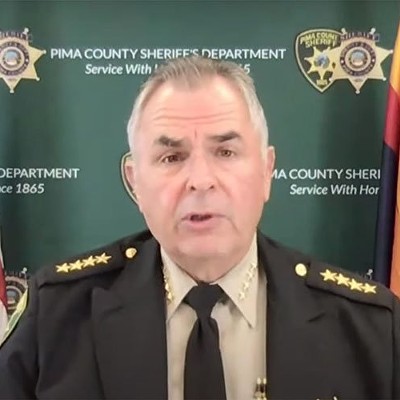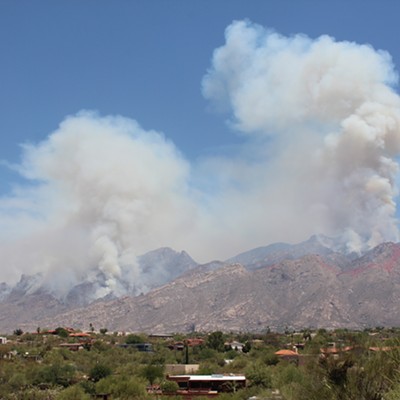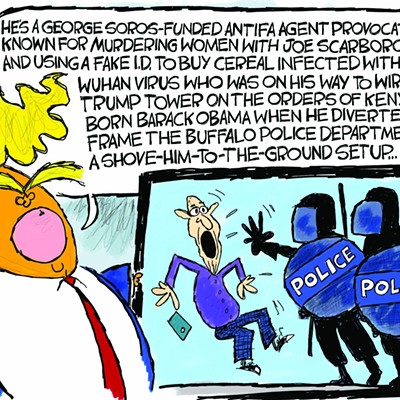Joseph Mucenski Sr. understands that encounters between police and mentally distraught folks can end badly. That's because his son experienced that kind of confrontation firsthand.
Joseph Mucenski Jr. was a chef at the now-defunct Café Terra Cotta back in 2000. The restaurant was relocating, and the pressure was fierce. There were also girlfriend problems.
He was 36, clinically depressed and suicidal one September night when two sheriff's deputies were called to his Skyline Drive apartment. And before the night was over, Joe Mucenski Jr. was dead.
Joe Mucenski Sr. is no shrinking violet. The retired New York City police detective has plenty to say about the night his son died. And he's put his words into action. Today, he's a board member with the National Alliance on Mental Illness. Soon after their son's death, he and his wife, Margaret, spearheaded Tucson's Crisis Intervention Network, which coordinates crisis-intervention team (CIT) training programs within the Pima County Sheriff's Department and in the Tucson Police Department. That has resulted in hundreds of officers gaining an exceptional understanding of the mental-health system, and strategy for defusing volatile encounters with the mentally ill.
Joe Mucenski Sr. just wishes someone had instigated that training a bit earlier.
"If this program had been in place here in 2000," he says, "my son would still be alive."
Training for Tucson's crisis intervention teams are loosely based on the "Memphis Model," named for the city where the concept first gained a foothold. At its core are 40 hours of training for roughly 20 percent of beat cops on any given force. Trainees learn techniques for calming the mentally ill, gain a few insights about the Byzantine mental-health system, and are provided with options for placing people who need help somewhere other than the county jail.
"We inform (officers) about what resources are available to them," says Laura Waterman, of the Southern Arizona Mental Health Corporation, or SAMHC, which provides part of the training. "They don't always know what they can do to get the person help.
Part of the training involves an overview of the public health system, and processes for committing the mentally ill to confinement for their own protection. "A patrol officer may be out there dealing with someone who is really in imminent danger of hurting themselves or someone else," says Waterman. "Under those circumstances, the police officer can petition the person to a hospital.
"Often, law enforcement comes across people who are clearly dangerous to themselves or to someone else, but not right at that minute. In many states, there's nothing you can do about that. But in our state, there's a lesser standard for involuntary hospitalization."
That gives patrol officers an extra tool for stopping bad situations before they start. "It often makes a difference in how they deal with a person," says Waterman.
And it works: According to recent study published in Schizophrenia Bulletin, such training dramatically reduces the number of violent confrontations between police officers and the mentally ill. Officers who had undergone CIT training were far less likely to use physical force when dealing with the mentally ill, and instead relied on more effective, nonphysical ways to de-escalate explosive situations.
The study showed that such verbal methods led to far fewer injuries among both officers and the mentally ill.
Despite this effectiveness, the participation of local law-enforcement agencies varies. The Tucson Police Department is a standout, with a system of "flagging" CIT-trained officers as first responders when a mentally ill person is encountered.
Although more than 150 deputies in the Pima County Sheriff's Department have this training, dispatchers don't automatically flag CIT-trained officers.
"But at any point in the day, there is going to be someone on who has that training," says Deputy Jason Ogan, a department spokesman. For instance, "most of our sergeants are CIT-trained. At any point in the day, there's always a sergeant on for each shift in each of our districts."
By contrast, the University of Arizona Police Department has resisted involvement in CIT training—which some suggest might have played a role in the May 21 encounter between a UAPD officer and a knife-wielding, apparently mentally ill woman. The cop shot the woman several times.
Some consider CIT's effectiveness to be limited when weapons are present. And while UAPD spokesman Sgt. Juan Alvarez won't comment on the May 21 incident, which is still under investigation, he dismisses the notion that his officers aren't well-versed in handling the mentally ill.
"Whenever we evaluate any training, we look at whether we have it in place already," says Sgt. Alvarez. "Currently, our officers go to the police academy and receive some training there. We also have training for responding to mental-health issues with the (Arizona Peace Officer Standards and Training Board) and with SAMHC."
His department also collaborates with mental-health specialists on campus "to continually talk about how we respond to incidences. The training that we have is very good for facing the issues we have on campus."
Joe Mucenski Sr. doesn't buy that. He says the training level described by Alvarez "isn't even close" to the standards set by the CIT program. "If the UAPD thinks their training is sufficient, then why does TPD and the Pima County Sheriff's Department think CIT is a necessary tool for them to have?
"I can tell you from my law-enforcement experience that the first officer who responds to a scene generally sets the tone and the outcome of that response," Mucenski says. "So if you don't have an officer who's trained in these types of situations responding to that scene, something (bad) is going to happen."
This he knows well, ever since that night in September 2000. He and his wife were at the scene, and pleaded with deputies to stop screaming at their knife-wielding, suicidal son.
After a horrid drama that seemed to play out for hours, they heard the gunshots that killed Joe Mucenski Jr.
And maybe it didn't have to happen.












